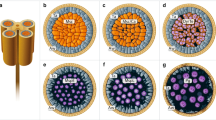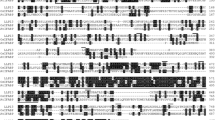Abstract
Glycoproteins 50, 55, 59 and 64 kDa with affinity to the lectin ConA occurring abundantly in mature tobacco pollen were shown to exhibit high tolerance against heating at 90°C for 30°min. The 59 kDa glycoprotein (GP59) was isolated by affinity chromatography on ConA-agarose followed by 2D-electrophoresis and identified by MS analysis as tobacco calreticulin with approximate pI 4.2. Identification of the protein was confirmed by immunoblotting with human anti-calreticulin and by labelling with a specific dye for Ca2+ -binding proteins (Stains All). Two acidic isoforms of 50 kDa glycoprotein in addition to GP59 displayed homology to calreticulin. RT-PCR revealed the presence of transcripts for calreticulin 59 kDa at all the stages of pollen development from microspore mitosis through the first 24 h of pollen tube growth. Immunodetection with anti-calreticulin and affinity to ConA on Western blots of total soluble proteins separated by 1D-SDS-PAGE showed that the protein first occurred at the mid-bicellular pollen stage, accumulated during pollen maturation and disappeared during 24 h of pollen tube growth. A thermotolerant form of GP59 was detected only in the terminal phase of pollen maturation and during 8 h of pollen tube growth. Results indicated that calreticulin 59 kDa is transcribed, translated and undergoes post-translational modification at a number of different stages of pollen development and that thermotolerance of the protein in mature pollen may be associated with high glycosylation. The thermotolerance of these glycoproteins could play a role in the protection of pollen against stress factors during dehydration and dispersal.




Similar content being viewed by others
References
Baldan B, Navazio L, Friso A, Mariani P, Meggio F (1996) Plant calreticulin is specifically and efficiently phosphorylated by protein kinase CK2. Biochem Biophys Res Commun 221:498–502
Borisjuk N, Sitailo L, Adler K, Malysheva L, Tewes A, Borisjuk L, Manteuffel R (1998) Calreticulin expression in plant cells: developmental regulation, tissue specificity and intracellular distribution. Planta 206:504–514
Burns K, Duggan B, Atkinson EA, Famulski KS, Nemer M, Bleackley RC, Michalak M (1994) Modulation of gene-expression by calreticulin binding to the glucocorticoid receptor. Nature 367:476–480
Campbell KP, Maclennan DH, Jorgensen AO (1983) Staining of the Ca2+ -binding proteins, calsequestrin, calmodulin, troponin-C, and S-100, with the cationic carbocyanine dye Stains-All. J Biol Chem 258:1267–1273
Chen FQ, Hayes PM, Mulrooney DM, Pan AH (1994) Identification and characterization of cDNA clones encoding plant calreticulin in barley. Plant Cell 6:835–843
Clark SE, Muslin EH, Henson CA (2004) Effect of adding and removing N-glycosylation recognition sites on the thermostability of barley alpha-glucosidase. Protein Eng Des Sel 17:245–249
Conway EM, Liu L, Nowakowski B, Steiner-Mosonyi M, Ribeiro SP, Michalak M (1995) Heat shock-sensitive expression of calreticulin. In vitro and in vivo up-regulation. J Biol Chem 270:17011–17016
Coppolino MG, Woodside MJ, Demaurex N, Grinstein S, StArnaud R, Dedhar S (1997) Calreticulin is essential for integrin-mediated calcium signalling and cell adhesion. Nature 386:843–847
Denecke J, Carlsson LE, Vidal S, Hoglund AS, Ek B, Vanzeijl MJ, Sinjorgo KMC, Palva ET (1995) The tobacco homolog of mammalian calreticulin is present in protein complexes in vivo. Plant Cell 7:391–406
Honys D, Combe JP, Twell D, Čapková V (2000) The translationally repressed pollen-specific ntp303 mRNA is stored in non-polysomal mRNPs during pollen maturation. Sex Plant Reprod 13:135–144
Hrubá P, Tupý J (1999) N-glycoproteins specific for different stages of microspore and pollen development in tobacco. Plant Sci 141:29–40
Hrubá P, Honys D, Twell D, Čapková V, Tupý J (2005) Expression of beta-galactosidase and beta-xylosidase genes during microspore and pollen development. Planta 220:931–940
Jethmalani SM, Henle KJ, Kaushal GP (1994) Heat shock-induced prompt glycosylation. Identification of P-SG67 as calreticulin. J Biol Chem 269:23603–23609
Laemmli UK (1970) Cleavage of structural proteins during the assembly of the head of bacteriophage T4. Nature 227:680–685
Lalanne E, Honys D, Johnson A, Borner GH, Lilley KS, Dupree P, Grossniklaus U, Twell D (2004) SETH1 and SETH2, two components of the glycosylphosphatidylinositol anchor biosynthetic pathway, are required for pollen germination and tube growth in Arabidopsis. Plant Cell 16:229–240
Lenartowska M, Karas K, Marshall J, Napier R, Bednarska E (2002) Immunocytochemical evidence of calreticulin-like protein in pollen tubes and styles of Petunia hybrida Hort. Protoplasma 219:23–30
Meldgaard M, Svendsen I (1994) Different effects of N-glycosylation on the thermostability of highly homologous bacterial (1,3-1,4)-beta-glucanases secreted from yeast. Microbiology 140:159–166
Michel D, Furini A, Salamini F, Bartels D (1994) Structure and regulation of an ABA-responsive and desiccation-responsive gene from the resurrection plant Craterostigma plantagineum. Plant Mol Biol 24:549–560
Navazio L, Baldan B, Dainese P, James P, Damiani E, Margreth A, Mariani P (1995) Evidence that spinach leaves express calreticulin but not calsequestrin. Plant Physiol 109:983–990
Navazio L, Sponga L, Dainese P, Fitchette-Laine AC, Faye L, Baldan B, Mariani P (1998) The calcium binding protein calreticulin in pollen of Liriodendron tulipifera L. Plant Sci 131:35–42
Nelson DE, Glaunsinger B, Bohnert HJ (1997) Abundant accumulation of the calcium-binding molecular chaperone calreticulin in specific floral tissues of Arabidopsis thaliana. Plant Physiol 114:29–37
Persson S, Wyatt SE, Love J, Thompson WF, Robertson D, Boss WF (2001) The Ca2+ status of the endoplasmic reticulum is altered by induction of calreticulin expression in transgenic plants. Plant Physiol 126:1092–1104
Saito Y, Ihara Y, Leach MR, Cohen-Doyle MF, Williams DB (1999) Calreticulin functions in vitro as a molecular chaperone for both glycosylated and non-glycosylated proteins. EMBO J 18:6718–6729
Sharma A, Isogai M, Yamamoto T, Sakaguchi K, Hashimoto J, Komatsu S (2004) A novel interaction between calreticulin and ubiquitin-like nuclear protein in rice. Plant Cell Physiol 45:684–692
Towbin H, Staehelin T, Gordon J (1979) Electrophoretic transfer of proteins from polyacrylamide gels to nitrocellulose sheets: procedure and some applications. Proc Natl Acad Sci USA 76:4350–4354
Štorchová H, Čapková V, Tupý J (1994) A Nicotiana tabacum messenger-RNA encoding a 69-kDa glycoprotein occurring abundantly in pollen tubes is transcribed but not translated during pollen development in the anthers. Planta 192:441–445
Říhová L, Čapková V, Tupý J (1996) Changes in glycoprotein patterns associated with male gametophyte development and with induction of pollen embryogenesis in Nicotiana tabacum L. J Plant Physiol 147:573–581
Žárský V, Garrido D, Eller N, Tupý J, Vicente O, Schöffl F, Heberle-Bors E (1995) The expression of a small heat shock gene is activated during induction of tobacco pollen embryogenesis by starvation. Plant Cell Environ 18:139–147
Wang H, Cutler AJ (1995) Promoters from kin1 and cor6.6, two Arabidopsis thaliana low-temperature- and ABA-inducible genes, direct strong beta-glucuronidase expression in guard cells, pollen and young developing seeds. Plant Mol Biol 28:619–634
Williams CM, Zhang GC, Michalak M, Cass DD (1997) Calcium-induced protein phosphorylation and changes in levels of calmodulin and calreticulin in maize sperm cells. Sex Plant Reprod 10:83–88
Acknowledgements
This research was supported by grant 522/02/D075 of the Grant Agency of the Czech Republic (PH), grant 1K03018 of the Ministry of Education of the Czech Republic (DH) and grant B6038409 of the Grant Agency of the Academy of Sciences of the Czech Republic (DH).
Author information
Authors and Affiliations
Corresponding author
Rights and permissions
About this article
Cite this article
Hrubá, P., Honys, D. & Tupý, J. Expression and thermotolerance of calreticulin during pollen development in tobacco. Sex Plant Reprod 18, 143–148 (2005). https://doi.org/10.1007/s00497-005-0007-z
Received:
Accepted:
Published:
Issue Date:
DOI: https://doi.org/10.1007/s00497-005-0007-z




